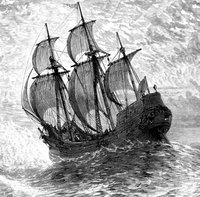Mayflower
|
|
The Mayflower was the ship which transported the Pilgrim Fathers from Plymouth, England to "North Virginia" (in what was later to become the United States of America) in 1620, leaving Plymouth on September 6 and dropping anchor near Cape Cod on November 11.
| Contents |
The ship
The ship Mayflower was used as a cargo ship trading between England and other European countries, principally France but also Norway, Germany and Spain. At least between 1609 and 1623 it was mastered by Christopher Jones, who was Captain on the trans-atlantic voyage, and based in Rotherhithe. He was buried in the graveyard of St Mary's Rotherhithe following his death in March 1623, and it is likely that the ship was broken up for scrap lumber there in the following year.
Details regarding the size and overall dimensions of the ship are unknown, but it has been estimated from its load weight and the usual size of 180-ton merchant ships in the period to be 90 - 110 feet in length and about 25 feet in width. Careful research went into designing a replica, the Mayflower II (launched on September 22, 1956), to make it as much like its namesake as possible.
The voyage
Initially the plan was for the voyage to be made in two vessels (the other being the smaller Speedwell). The first voyage of the ships departed Southampton, England on August 5 1620, but the Speedwell developed a leak and had to be refitted at Dartmouth. On the second attempt, the ships reached the Atlantic, but once again were forced to return, to Plymouth. After some reorganisation the voyage was made in the Mayflower alone. Their intended destination was a section of land in the area near the Hudson River. Forced off course by poor weather, the Mayflower arrived at Cape Cod after 65 days at sea.As a result of the delay, the settlers did not arrive until the onset of winter, which made for a difficult time for them.
Before disembarking, the settlers wrote and signed the Mayflower Compact.
On April 5, 1621 the Mayflower set sail from Plymouth Colony in Massachusetts on a return trip to England, arriving back on May 6, 1621.
Mayflower passengers
The passengers on the Mayflower were the earliest permanent settlers in New England, and so later many members of society took great interest in tracing their ancestry back to one of these. See list of passengers on the Mayflower for a complete accounting. See also List of Mayflower passengers who died in the winter of 1620 - 1621. See some of the descendants of these Mayflower Pilgrims in this Mayflower Descendants Chart at http://www.familyforest.com/Mayflower_Descendants.html
Mayflower in culture
The voyage and the ship later became famous, virtually an icon of a perilous one-way trip to a new life, and many different kinds of things have been named after it.
The Mayflower is the emblem of the English football club Plymouth Argyle F.C., who are known by the nickname of "The Pilgrims".
External link
- Mayflower II (http://www.plimoth.org/visit/what/mayflower2.asp) at Plimoth Plantation Museum
- Mayflower passengers (http://www.mayflowerhistory.com/Passengers/passengers.php) from MayflowerHistory.com
- Mayflower history (http://www.mayflowerhistory.com/History/history.php) from MayflowerHistory.com
- Pilgrim Hall Museum (http://www.pilgrimhall.org) of Plymouth, Massachusetts
- General Society of Mayflower Descendants (http://www.mayflower.org)
- The Mayflower And Her Log (http://www.gutenberg.net/browse/BIBREC/BR4107.HTM); Azel Ames, Project Gutenberg edition.
- The First Ships Discussion List Homepage (http://www.feliixplace.com/genealogylists/firstships.html)

